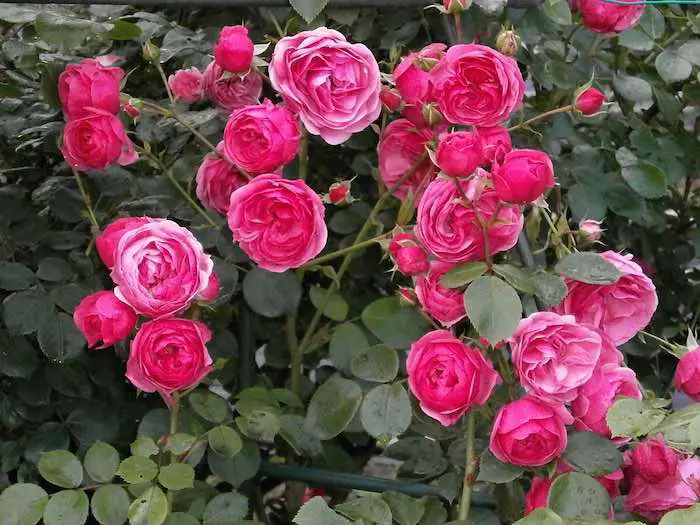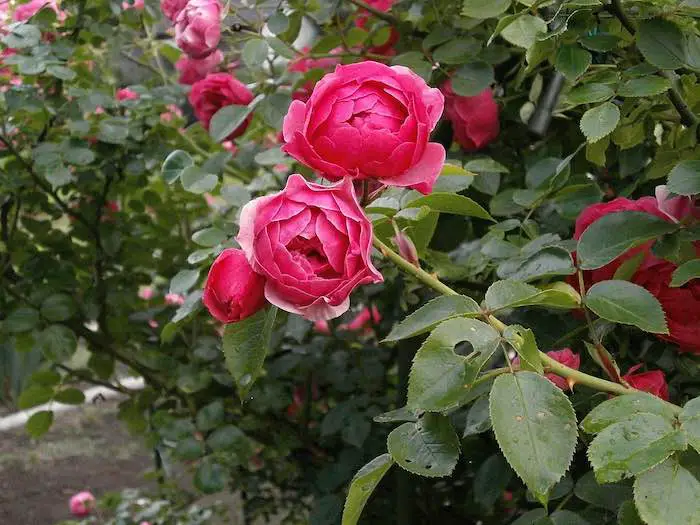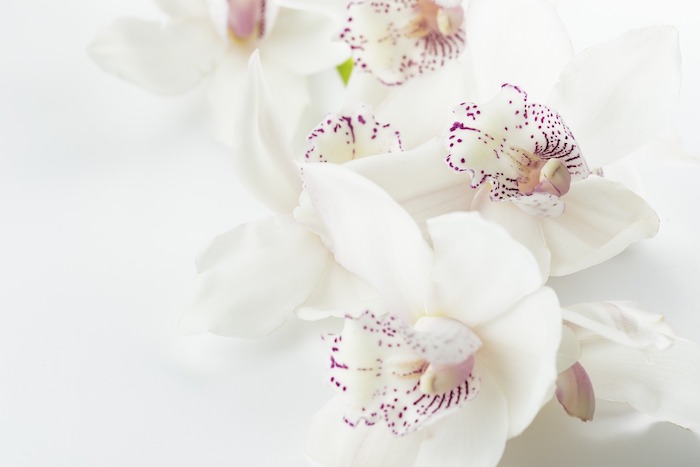When you think of roses, you think of beautiful, fragrant flowers that make an attractive decor on your home or in your front yard. They provide color and vibrance to your home, and these flowers are very pleasing to the eye.
Unlike full-sized roses, miniature rose bushes are hybrid plants that are made to breed into smaller versions of their standard-sized counterparts. The “miniature” in these bushes refers to the size of its bloom and not its bushes. These roses appear in various kinds and colors, and their sizes range from 5 inches to 36 inches.
These mini rose bushes are as fragrant as their regular-sized counterparts and they are a great addition to one’s home. Despite their small and delicate appearance, miniature rose bushes are remarkably hardy. While miniature rose bushes have the needs as their full-sized counterparts, the former tends to be easier to care for because of its size.
If you would like to have a miniature rose bush in your garden, you’re wondering, “How do I take care of a miniature rose bush?” There are many factors to consider to care for these plant species that it may get overwhelming. In this extensive yet comprehensive guide, we have compiled all information, ideas, and tips you would need from selecting your rose bush to taking care of them.
Caring for Miniature Rose Bushes
Here are some things you need to keep in mind when caring for your new miniature rose bushes so that they can blossom into healthy and vibrant flowers.
Climate
Your location’s climate plays a big factor since it is ideal to grow miniature roses outdoors. While most roses grow and bloom best in warmer climates, these flowers are hardy plants that are able to survive colder months as well.
The United States Department of Agriculture has created a system to determine the plant’s hardiness zone or climate zone, which contains a certain range of climate condition that plays a huge factor in the plant’s growth and survival.
To know your location’s climate zones, look up “climate zones” or “hardiness zones” online, and choose a website that provides a climate zone calculator. Once you find a website that provides the hardiness zone calculator, enter your ZIP code, and the website will give you a number with a letter that corresponds to your location’s climate zone.
As the hardiness zone gets lower, the winters get colder and harsher. Rose bushes grow best in climate zone 4-11.
If you don’t live in this specific climate zones, your rose bushes may not survive or grow well outdoors, so you may want to consider growing them indoors in containers. Just make sure they receive enough sunlight.
Where To Plant: Outdoors vs. Indoors
Like most plants, sunlight plays a significant factor in terms of where you would like to plant your rose bushes. Ideally, choose a spot where miniature rose bushes get abundant sunlight. It is important to make sure that your rose bush receives at least 6 to 8 hours of direct sunlight.
Growing Your Roses Outdoors
For best results, you may want to grow your miniature rose bush outdoors where they receive plenty of direct sunlight. You also might want to plant them in your front yard to add color and vibrance to your garden.
As mentioned previously, ensure that your miniature rose bush gets at least 6 hours of direct sunlight, so it is important to choose a spot where there is no shade. It’s best to also plant these rose bushes on the south side or west side of the house so that they can get enough direct sunlight.
If you’ve grown your rose bushes indoors and want to transfer them outdoors, it is important to expose your plants gradually to the sunlight so that they don’t burn. It’s a great idea to begin with a few hours of sunlight and slowly increase the plant’s exposure. If the leaves seem to burn, reduce the exposure for a few days, and gradually increase.
Planting Your Roses Indoors
If your location’s climate zone is not suitable for growing miniature rose bushes, or you simply want to keep these rose bushes indoors for whatever reason, you might want to keep them in containers inside of your home.
When growing your miniature rose bush, keep in mind to place them by windows facing south or west in order to receive direct sunlight. This is important in darker and colder months of the year, and, as soon as you get to the hotter months, you may want to move your plants slightly away from the window to prevent them from burning.
To make sure your miniature rose bushes receive equal amounts of sunlight, rotate your plants every 1-2 weeks so all areas are covered.
Another thing to remember as you grow your rose bush indoors is that, if the plant seems to be reaching out towards the light or appears to fall over and become thin and “leggy,” then the plant might not be receiving enough sunlight.
When you decide to plant your roses indoors, you also need to consider selecting a container your miniature rose bush. For containers, it is best to choose a pot or container that will hold the soil and has a similar size as an old coal bucket. Additionally, DO NOT get a clear container as you will be risking damaging the plant’s roots.
To prepare your container, it is important for containers to have drainage holes. If they do not come with drainage holes, then drill 3-8 inch holes at the bottom of the container.
If you plan to keep your rose bushes indoors for a long time, you might want to fertilize them more to keep them healthy.
Here’s another piece of equipment you may want to consider if you are serious about getting a miniature rose bush and prefer to plant indoors, but this is completely optional. Since miniature rose bushes require a ton of sunlight, you might want to consider getting an artificial grow lights.
It is a good idea to alternate between cool white, warm white fluorescent, and incandescent lights, but don’t keep them on all the time as roses need their period of darkness too.
Soil
For best results, you should grow roses in rich, well-drained, loamy soil for excellent health.
If you’re planting rose bushes outdoors, it’s important to cover the soil with a 2-4 inch layer of mulch, which prevents stress on the plant, conserves water, and helps with the plant’s healthy growth. You must also water your roses until the soil is thoroughly soaked right after planting. By doing this, it can help the roots assimilate into the soil.
Keep in mind, you must prevent the soil from being soggy as overly-wet soil can lead to fungi problems and can cause the root to rot. As for the pH levels of the soil, it should be in-between 6.0-7.0.
For indoor miniature rose bushes, you must get a soil mix that contains nutrients and drainage levels appropriate to the rose you have selected.
Fertilizer
A healthy rose bush produces more blooms and also able to ward off pathogens. While roses are able to survive without fertilizers, they are negatively affected in terms of health.
Like all plants, a miniature rose bush needs a suitable fertilizer to grow healthily, and it is key to remember that roses are generally heavy feeders. Fertilizing regularly is important as miniature roses continue to bloom all season.
You should use a balanced fertilizer or a dilute fertilizer solution and start fertilizing your roses in the spring. You can also use any rose food or all-purpose fertilizer and apply according to your miniature rose bush’s needs. If for any reason, you do not have access to fertilizer, compost is also a good alternative to feed your roses.
Some key tips to remember when feeding your roses:
- Fertilize them every 2-3 weeks
- Feed when the bush first leafs out, and then, feed it again after every flush of blooming.
- Don’t feed about 6-8 weeks before the first expected frost to prevent new growth that would be killed during the winter.
Watering
Similar to their regular-sized counterparts, miniature rose bushes require ample amounts of water as the soil absorbs water and dries out quickly. To grow and blossom beautifully, you must water your miniature rose bushes on a regular basis.
Ideally, you must hydrate your roses with water every 1-2 days. Before doing so, it is important to check your soil’s moisture level by sticking your finger all the way into the soil.
To water your roses thoroughly and properly, put your gardening hose at the base of the roses and let the water run for about a minute until the soil is completely soaked.
Useful Tips To Keep In Mind When Watering Your Miniature Rose Bush

- You should provide 1 inch of water each week, but some people are encouraged to provide at least 3 inches of water for the week.
- For the first three weeks, you may need to water your roses every day depending on your location.
- In addition to watering your rose bushes, it is advisable to spray a light even layer of water mist on to the flowers and leaves themselves as it keeps the flowers clean and provides moisture to the plants.
Deadheading and Pruning
It is normal for any plant to age and to wither. For a miniature rose bush, it is important to deadhead and prune them as they start to age.
Deadheading
As soon as your rose bush starts to fade, lose their color, and begin to wilt, it is time to deadhead the roses.
Deadheading roses refers to the removal of old blooms, which essential as it encourages more plants to produce more flowers.
To deadhead roses, you must cut the stem directly below the flower at a 45-degree angle. Some gardeners prefer to do the 5-leaf junction method, where they prune old flowers down to the first 5-leaf junction with a cane at a slight angle.
Meanwhile, some people prefer to twist and snap the flower off its stem as it is quick and easy, but it doesn’t really look good on your rose bushes, so it is advisable not to do this method.
As you begin to deadhead flowers, here are some tips to keep in mind.
- Don’t pull the flowers with your fingers because this destroys the plant and encourages diseases.
- Make sure to use sterilized pruning shears.
- Cut off dead leaves and stems as you deadhead flowers.
- Sterilize your pruning equipment before and after to prevent diseases on your plant.
Pruning
Similar to deadheading, pruning encourages healthy plant growth. Pruning is actually the removal of dead branches.
The best time to prune miniature rose bushes is during fall season as days begin to grow shorter, and sunlight gradually becomes less.
To prune, be sure to use proper pruning shears that are sterilized before and after. Cut at a 45-degree angle and a quarter-inch above the plant’s leaf axil.
Repotting your rose bush
Developing miniature rose bush means adding more roots. If you do not change your miniature rose bush’s container, the roots will be overcrowded, and its growth will stagnate.
It is important to check if your roots are overcrowding or if there is two plants in one pot.
If the roots begin to overcrowd, then it is time to change your pot. If you see that there are two plants in one pot, it may be the perfect time to separate them.
To transfer the containers of your miniature rose bushes, you must slowly detach the roots with your fingers and do your best to remove the plants’ original soil. Then, use a pot slightly bigger than your original pot and ensure that the pot has drainage holes.
Related Questions
What are the common diseases that miniature rose bushes face, and how do you treat them right away?
Like other plants and other kinds of roses, miniature rose bushes are vulnerable to problems, diseases, and pests.
Miniature rose bushes tend to develop black spots, which are fungi that need to be addressed immediately. To treat it, cut off the affected parts and put some fungicide specifically for black spots on its foliage.
You can also prevent black spots and other types of fungi by providing good air ventilation.
How do you deal with pests?
First, you need to determine which pests are bothering your rose bush.
If you are dealing with spider mites, which are pests hiding under miniature rose foliage, it’s important to keep the plant free of dust and moisture. You may also get use insecticide soaps to get rid of spider mites. The key is to apply the insecticides on cooler times of the day.
With caterpillars, you may also want to use an insecticidal spray to ward them away.
Another common one is a rose slug, which looks like a thick worm that crawls up the rose’s stems. To deal with them, you must pick up these slugs individually by hand and use insecticides to ward off rose slugs.
Are temperature and humidity big factors for a miniature rose bush?
Humidity and temperature play a key part in taking care of a miniature rose bush. Miniature rose bushes need direct sunlight and medium humidity.
During the driest seasons like summer or winter, rose bushes tend to immediately dry out, so pay attention to that.
However, humid weather and overly damp conditions may cause plants to be more vulnerable to fungal diseases, such as black spots. It is important to prevent the leaves from getting wet to avoid these diseases.
Final Thoughts: How to Take Care of A Miniature Rose Bush
Whether you want to plant your rose bushes indoors or outdoors, miniature rose bushes provide vibrance, beauty, and color to one’s home similar to regular-sized rose bushes.
These rose bushes may appear delicate, but they are tough hardy plants. With tender, love, and care, these miniature rose bushes are a great addition to your plant collection.
See Also:
Average Lifespan Of A Garden Snail
Are Orchids Fragrant? (Here’s The Answer)
Why Are My Orchids Flowers Falling Off
Ultimate List Of Fragrant Orchids
Best Way To Grow Sunflowers Indoors
5 Best Greenhouse For Windy Areas


